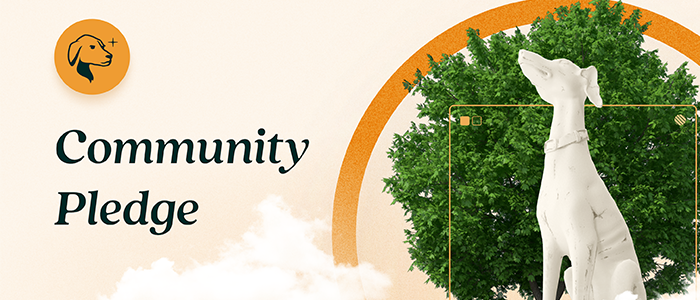How Permissionless Community-Owned Tools Will Run Web3
Article by Hiro Kennelly Edited by Trewkat and Frank America Cover by ab_colours
If the last few weeks in crypto have taught us anything, it’s that decentralization is more important than ever. Earlier this month, the U.S Treasury’s Office of Foreign Assets Control sanctioned Tornado Cash, the Ethereum-based privacy mixer, and subsequently, one of its chief developers was arrested by Dutch authorities. Protocols are blocking wallet addresses for having interacted with or even having been sent unsolicited crypto via Tornado Cash, and there’s talk of censoring transactions at the validator level.
The Tornado Cash sanctions have exposed a readiness by certain protocols and projects to build back up the walls Web3 has been tearing down. Is this the Web3 world in which you want to work and play? For the people at Tally Ho who are building a new kind of Web3 wallet, the answer is a clear ‘no’. Tally is not alone, of course, as they are following in the footsteps of internet and Web3 pioneers. But Tally is also leading the way with a wallet-signed Community Pledge centered around permissionless access, open-source code, and community ownership. People deserve Web3 wallets that aren’t controlled by a centralized authority.
Following the Tornado Cash sanctions, a clear divide emerged within crypto, but the schism was uncovered rather than created. Some protocols and companies immediately broke ties with Tornado Cash; Aave blocked suspect wallet addresses, and GitHub took down Tornado Cash’s open-source code. Granted, organizations like Aave (who deal with a large amount of USDC, which also blocked the sanctioned addresses), may have needed to remain on the right side of regulation in order to maintain their business model, and Aave did restore access for the dusted wallets. And yet through these actions, we saw just how easily centralized protocols can censor blockchain transactions. It was a glimpse of one type of future, but it’s not the only way.
In other corners of the Metaverse, many Web3 stalwarts were surprised and outraged by the sudden capitulation of protocols and projects to the will of the U.S. Treasury, by the utter abandonment of the core values upon which Ethereum, and the early internet, was built. Developers and users lit up crypto Twitter, calling for a return to the roots of Web3 and a reaffirmation of its core principles, while organizations like coincenter.org made the case that sanctioning the Tornado Cash smart contract was a violation of constitutional due process and free speech rights. While code may not be law, it certainly is protected speech.
Among the companies that blocked wallet addresses was Infura, which is one of only a handful of blockchain infrastructure providers. Infura is owned by ConsenSys, the $7-billion crypto-conglomerate behind the MetaMask wallet. Did you know that when you use MetaMask, you are enriching the multi-billion-dollar company that maintains restricted access to MetaMask’s code and has censored transactions through Infura? Now you do.
A Web3 Wallet With a Soul

Image credit: Tally Ho
Sadly, vertical monopolies, centralized control, and censoring code are not the principles upon which Web3 is built, but are becoming pervasive due to the potential for profit in this industry. If you want to understand and live by positive Web3 principles, look instead to Tally Ho. The team that is building this new community-owned wallet has a deep history of supporting open-source code, decentralization, and self sovereignty. What’s truly revolutionary is that they are building a best-in-class wallet that is open-source, community owned, fully composable, and has funding for public goods built into its source code. When the community tokenizes, a DAO will be born — funded by the revenue earned through swap fees and other in-wallet activities.
Tally Ho is building a public-goods-oriented protocol focused on enriching the wallet’s ecosystem and supporting wider Web3 initiatives, all sustained through the use of its product. This new way of building open-source consumer products — where product usage funds both the development of the protocol and the flourishing of the greater crypto ecosystem — may become the default method of building in Web3, but only if we continue to support protocols and projects that put the ethos of Web3 front and center.
The Web3 community strongly values decentralized and distributed ownership of our tools, protocols, and platforms amongst users and builders, sovereignty over our data and content, composability and open-source software, permissionless building, and the idea that together we can build a future of equitable and sustainable abundance — all enabled by trustless, immutable, and permissionless blockchains.
If we pay only lip service to the importance of community ownership and permissionless access, of creator rights and open-source code, if we continue to use the tools that promote centralization of power and a concentration of capital and resources, then we are just building Web2 on blockchain rails. This is not why we are here, and it’s time to make our intention known.
ZORA and Lens Lead the Way

Image credit: Publisher
One way to make your position clear in this battle for the future of Web3 is to support Tally Ho: use a Tally Ho wallet, join the Discord, participate in governance, and help to continually improve your new Web3 wallet. And Tally Ho is traveling with others on this journey to fortify the products and protocols we use with the ethos of Web3. The teams behind the creator-centric NFT protocol ZORA and the social graph Lens Protocol are both also at the forefront of this new epoch, developing their protocols with these core values in mind.
One of Web3’s core departures from Web2 is centered around ownership. ZORA is an NFT platform that inverts the typical marketplace model; instead of charging trading fees it encourages creators to become economically sustainable by launching their own marketplaces on their own terms. ZORA calls itself a universal media registry protocol, and it’s a platform full of tools designed to enable creators to retain ownership of their work and ship it to the world. Nearly two years ago, ZORA somewhat provocatively introduced its vision for “something transparent, ownable, accessible, financially sustainable, where we can share the value we create, something for the community, something that’s ours”, what it called Collective Creation:

This tweet introducing ZORA’s Manifesto was one of the opening salvos in the battle for the future of the internet, for the next evolution of a more equitable blockchain-based capitalism. In ZORA’s vision, the new economic model rewards creators for their cultural contributions, but also fosters communities who build together based upon a set of shared values, where the builders and users harness these cultural values to generate economic value for their community. You might even call this type of model a public good.
Although anyone can tweet the ZORA Manifesto, Lens went so far as to build a new kind of decentralized application, the petition dApp. Lens takes direct aim at Web2’s data and content ownership model. In contrast to that closed corporate loop, the Lens Protocol is an open-source, composable and permissionless social graph, which really means it’s a mashup of social networks and the blockchain, all built with NFTs on Polygon. Lens enables builders to create social platforms, and content creators to own and share their content with an audience that goes with them wherever they go.
Although the protocol was nearly a year in the making, at the beginning of February 2022 an open letter began to make the rounds on Twitter:

This letter, entitled “Own Your Digital Roots” stated, in part, “We spend time building a unique selfhood across platforms, but we know they are antiquated, centralized systems. Web3 brings forth a renewed hope…It offers the ability for us to control how our content is used. We can have the power to own and monetize our content and community with no middlemen or centralized data harvesting.”
Like ZORA’s Manifesto, this open letter is based on core Web3 values. However, to sign this open letter, you had to sign it with your crypto wallet, and the first ever dApp petition was born. In early May 2022, signatories of the letter were given access to the Lens Protocol and have been building a new kind of social network ever since.
The Community Pledge

Image Credit: Tally Ho
Tally Ho has an ambitious mission — to wrest control of Web3 from multi-billion dollar companies. MetaMask is only one example; Trust Wallet, Binance, and Coinbase Wallet are others. These well-funded wallets are not going down without a fight. For the protocol to function at scale, the Tally Ho community will need to take full advantage of its innovative DAO governance structure and flow-of-funds model to put the flywheel into effect. But none of this matters if you’re not building for the right reasons.
Like ZORA and Lens, the Tally Ho Community Pledge is grounded in the belief that a centralized, corporatized, and censored internet is the wrong path forward, and that the future of the internet is firmly rooted in permissionless access, open-source software, and community ownership. Tally Ho invites us to “imagine a community-owned wallet that actually embodies and protects Web3 values — a wallet that’s available to anyone, anywhere on Earth, that can finance itself, that’s governed by a DAO, and that’s accountable to you, not some faceless corporation. Well, that’s Tally Ho: a Web3 wallet for everyone, built to safeguard your assets and your rights.”
The Community Pledge is a distillation of this sentiment, and signers are certifying their belief in a sort of Web3 Bill of Rights: universal access to Web3, open-source code, and full community ownership. Although there is no indication yet as to what the incentive or reward might be for signing the Community Pledge, Tally Ho has teased that signing it with your Tally Ho wallet (download then pledge!) is “the best way to show support ahead of our DAO launch and it’s the first step in becoming a verified member of our community.” So while we don’t know what kind of surprise Tally Ho has in store for verified signers, the Community Pledge stands alone as something worth signing in the absence of any rewards. We’re fighting for the soul of Web3, after all.
Aligning Values With Action

Image Credit: Tally
Many of us believe in the permissionless world made possible by Web3, and naturally align with products like a DAO-owned Web3 wallet. Not many of us would knowingly stand for a corporatized blockchain future, where the same interests control access to new ways of socializing, of sustaining, of being. If we knew this was a likely future, we would damn sure work to stop it. Now is the time to put in that work.
Web3 presents a once-in-many-generations opportunity to build a new economic paradigm based on shared abundance, owning your means of production, and embodiment of the idea that a community which builds together thrives together. If this is the kind of world you want to live in, download the Tally Ho wallet, sign the Community Pledge, join the Discord, get active on the Forums, and help spread the word about what Tally Ho is building. With your help, we can win the fight for the soul of Web3.
Bios
Author:
Hiro Kennelly is a writer, editor, and coordinator at BanklessDAO and the Editor-in-Chief at Good Morning News. He is also helping to build a grants-focused organization at DAOpunks.
Editors:
Trewkat is a writer and editor at BanklessDAO. She’s interested in learning as much as possible about crypto and NFTs, with a particular focus on how best to communicate this newfound knowledge to others.
Frank America is a Co-founder of The Rug News, and a Content Manager at Bankless Publishing.
Designer:
ab_colours is a versatile designer with over seven years of experience. He specializes in doing product design, UX design and brand identity. He has been DAOing for the past eight months and has been able to amass quite a lot of knowledge about the fascinating blockchain space.
BanklessDAO is an education and media engine dedicated to helping individuals achieve financial independence.
Bankless Publishing is always accepting submissions for publication. We’d love to read your work, so please submit your article here!
This post does not contain financial advice, only educational information. By reading this article, you agree and affirm the above, as well as that you are not being solicited to make a financial decision, and that you in no way are receiving any fiduciary projection, promise, or tacit inference of your ability to achieve financial gains.
More Like This
Tally Ho’s Web3 Wallet Is Best in Show by Hiro Kennelly
Tally’s Community-Owned Crypto Wallet is a New Web3 Public Good by Hiro Kennelly
MakerDAO Lets Money Grow on Trees by Kalex1138
